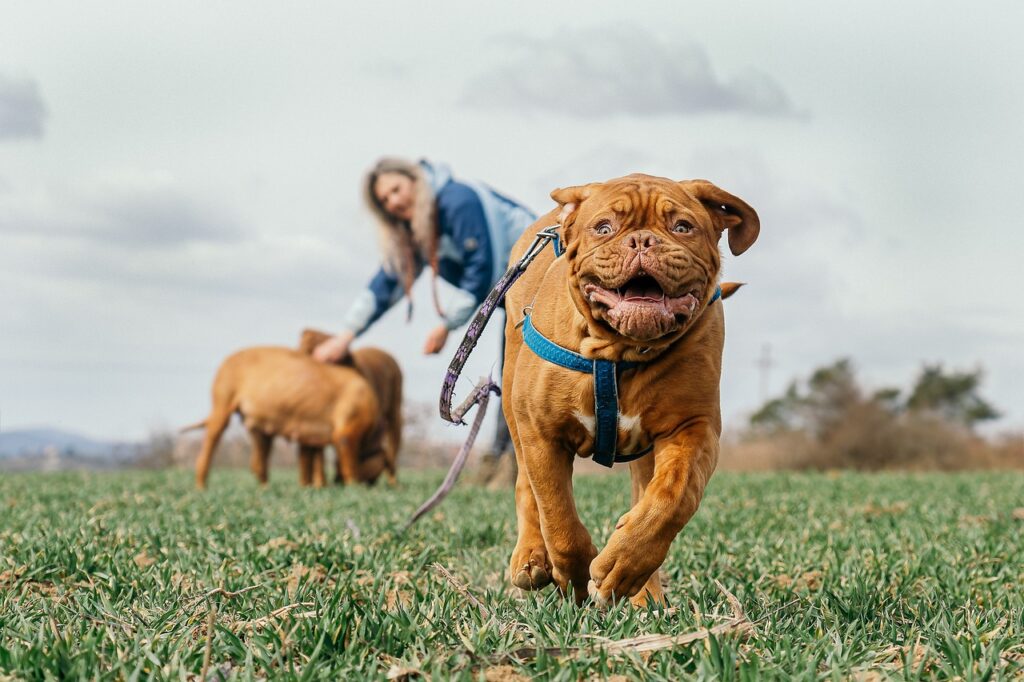Recall is a life saving skill.
You can do all the safety management in the world and there will still be times when your management fails.
You can teach your dog to wait at the door, at the gate, walk beside you outside, and you can make sure your dog is set up for safety by closing gates and doors and keeping your dog on a leash.
But what happens if that leash breaks when they see a squirrel, or worse a skunk?
What happens if a service worker accidentally leaves your back gate open and you let your dog outside before realizing what’s happened?
A lifesaving recall can make all the difference.
Having a good recall for my own dog has saved us.
There was a heart stopping moment one night when a new dog sitter came to meet us at our home. We chatted about my dog’s needs and in the middle of the conversation, she needed to go outside. I let her out, not thinking anything of it and continued to communicate with the new sitter.
We got to talking for a while and suddenly I realized my dog had not asked to come back inside. While she usually likes to be outdoors, it was odd that she hadn’t asked to come back in for some time.
I glanced outside and realized immediately what had happened. I had forgotten to tell the sitter that the front gate of our home connected to our backyard. They had left the front gate open and were mortified once they realized their mistake.
It was dark and I couldn’t see my dog at all.
My family began to panic.
I took a deep breath, called my dog, and instantly heard the faint jingling in the distance of her dog tags.
She came straight back. No hesitation. No delay. Just a happy face trotting back home to see me.
I praised her profusely and we went inside to celebrate her quick return. The sitter apologized, but if I was being honest, I was just as much to blame for not telling them about the gate situation. The way our home is set up does not make it obvious that the gate is connected from the front yard to the back.
I was able to take a heart stopping moment and keep it from turning into an emergency, all thanks to teaching my own dog a reliable recall.
We want to make sure that our clients are set up for success if these things were to ever happen. Humans make mistakes and so do dogs. Is my dog supposed to leave her yard? No. Did she? Yes. Are we supposed to leave the gate open? Nope. Did we? Yep.
In honor of this experience, I have decided to give my top recall tips.

You want a dog who comes racing back to you when you call.
You want a dog who shows no hesitation.
Here are my tips to help you get that lightning response.
I want you to picture yourself in your favorite place, somewhere with lots of your favorite things to look at or do. This could be a hike in the woods, your favorite store, a museum, or at a concert.
Now I want you to imagine there’s someone calling you away from this fun area.
You decide to heed the call and leave the fun area to check in with them. When you get there, you ask them what’s going on and they say “Oh, nothing, I just wanted to see you.” Now, if you like this person a lot, you may find this rewarding, but most people I know would wonder why that person didn’t just catch up with them instead.
You’d like to go back and explore some more, so you leave again. Again, the person calls you back. You go back to them and get the same response.
How many times would you keep doing that? It might depend on who the person is. But nonetheless, they keep interrupting your exploration. Why can’t they come to you instead? You are a little busy, after all, and all the fun is happening away from where they are. What’s worse, the last time you come to them, they make you leave the fun place.
Now imagine a different scenario. You are out in your fun place having a great time. This time when the person calls you away and you respond, they have something to show you that is more fun than what you were originally doing.
Next time when you wander away again, they call you back and it turns out they found this other super fun and cool thing that you like. Somehow, they know exactly what sparks your interest. It could even be something that’s already in the environment you’re in. Maybe you’d wander away again or maybe you’d explore this fun place together, checking in with each other along the way.
This scenario is the kind of set up we want to create for our dogs when we teach a recall. Leaving fun stuff is hard, and when we ask our dogs to do a recall, we ask them to leave fun behind. To get a good recall, you have to know what rewards are worth it to your dog and every dog is different.
We often talk about using high value food to reinforce recall for dogs, but sometimes food is not as valuable as fun. Some dogs do better if their reward for recall is a play session with their favorite toy and person.
Know what rewards your dog loves. If you aren’t sure, take the time to experiment in a safe way to find out. And know that these rewards can fluctuate. Maybe your dog loves playing tug, but after an hour and a half of playing tug, coming back to play more might not be more interesting than smelling the grass calmly, or laying in a comfy spot in the shade.
This is the hardest thing for humans to do. If we get no response when we speak and ask each other something, we usually try repeating ourselves a little louder or more clearly than before.
This usually works with people and we have been reinforced for saying phrases louder and clearer. However, this doesn’t work so well with dogs. It is a very hard habit to break and I even find myself doing it from time to time with my own dog. However, most dogs have excellent ears.
Chances are, your dog heard your recall cue but it didn’t have meaning to them in the moment.
Repeating yourself is likely to turn “Fido, Come!” into “Fido, come! Come! COME! C O M E !”
When Fido finally turns around, he has learned the cue is “come” repeated four times with greater intensity and volume, instead of one time. Or worse, Fido does not come and he learns that “come” is just something the human shouts sometimes.
Humans make a lot of noise and it’s up to us to make sure that specific noises have value and meaning. Forcing yourself to say your cue word once can help you understand if your dog is responding to the cue. If they don’t, repeating it is not the answer.
Instead, try making other happy excited noises, like kisses, whistles, or silly sounds. Overtime, you can fade that out to just the cue word.
The goal is to throw a party and make your dog realize he’s missing out. Whatever behavior you can do to get your dog interested in coming over to you is a win, so don’t be afraid to act goofy and make silly noises for the sake of your recall. If acting excited isn’t enough to get your dog’s attention, you might need to break down teaching your recall at an easier level first.
Speaking of breaking things down, make sure to start with small expectations. Your first step is making sure your recall cue works in the house with minimal distractions and at a short distance. Once that is going well, start adding distance inside your home with minimal distractions. You can even play fun games in the house like hide and seek to teach your dog to come find you when they can’t see you, like when my dog was out of sight that night in the dark away from my home.
Now, here’s the trick: when you add in distractions, shorten your distance expectations first. For example, go outside in the backyard but keep your dog on a shorter leash. Work your recall there first and then start adding in more distance as they get better. You can add more distance safely by attaching multiple leashes together or getting a long line to practice. You’ll know your dog is ready to progress by how quickly they are responding to their cue.
Then do the same process in the front yard. When your dog is learning, you want to lower your expectations every time you are in new environments or around new distractions. Once you’ve put in this work, you will have a dog who is responsive in many new situations. We have to work slowly. This is the fastest way to getting a good recall in new situations. Take your time and let your dog take their time, too.
And there you have it, our top tips to getting a steady recall. These tips are just a few of the ones we talk to our clients about.
If you find yourself still struggling with recall, contacting us might just be your next step. We help clients with recall all the time and getting to know you and your dog as individuals can help us make a training plan designed and tailored for you. We offer group classes, private lessons, and drop-off training options so you can get the training plan that fits your needs.

Want a stellar recall?













